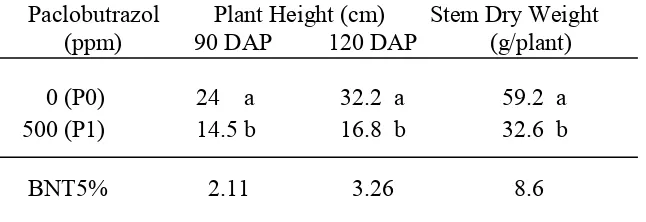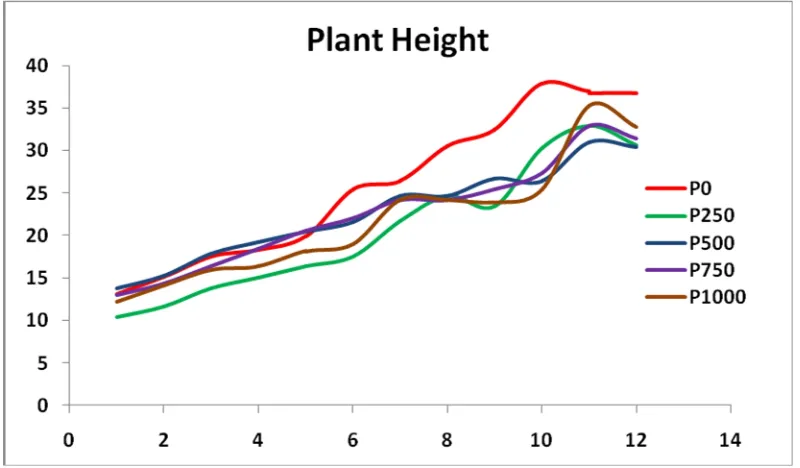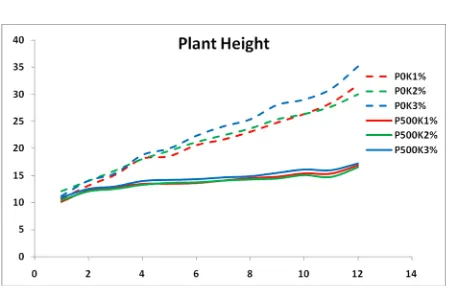FLOWER INDUCTION OF CASSAVA (Manihot esculentaCrantz) THROUGH THE APPLICATION OF PACLOBUTRAZOL AND KNO3
ERWIN YULIADI AND ARDIAN
Department of Agrotechnology, University of Lampung, Indonesia
ABSTRACT
Effects of Paclobutrazol and KNO3 on the induction of Cassava (Manihot esculenta Crantz)
flowering were observed. Two experiments were set up. In the first experiment
paclobutrazol was sprayed through plant leaves in five concentrations consisted of 0, 250,
500, 750, and 1,000 ppm. The second experiment was set up to investigate the effect of
paclobutrazol applied through the soil with two concentrations consisted of 0 and 500 ppm
and KNO3 with concentrations of 1%, 2%, and 3% applied through the leaves. The results
showed that 500 ppm Paclobutrazol reduced the vegetative growth and it was effective in
stimulating flower. Additionally, Paclobutrazol applied through the soil did not affect the
flower induction. There is no interaction effect between Paclobutrazol and KNO3 on the
vegetative growth and induction of flower.
productivity can be reached through breeding program. In most crops, however, yields can
be increased through crossing if the flowers of parental plants bloom at the same time.
Unfortunately, in low land area the flowers of many clones of cassava appear in different
time which brings into the difficulty in crossing the cassava plants to get better genotypes.
Alves (2002) reported that flowering of cassava plant is affected strongly by
environmental factors. In some clones flower induction depends on photoperiod of more than
13,5 hours and also related to temperature. Flower initiation of cassava is very important
because flower of most clones of cassava needs relatively a long time and most cassava
makes the breeders unable to increase characteristics diversity of cassava plants towards
better genotypes of new clones of cassava through crossing among clones.
One of the attemps to get the flower of some crops is the use of plant growth regulator
such as paclobutrazol. Some researchers have been successful to induce the flower of some
crops by using paclobutrazol such as orange (Poerwanto and Inoue, 1994), mango (Martinez
et al., 2008). The mode of action of paclobutrazol is the inhibition of gibberellic acid
synthesis in plants. The induction of flower in cassava was indicated by the formation of
branches at the end of the primary stem, the number and the size of leaves reduced (Halsey,
et al., 2008).
However, the application of paclobutrazol often can cause vegetative and generative
apical dormancy. To break the dormancy, Bartolomew and Criley (1988) used KNO3 10-40
g/l to induce the flower of mango. Assuming that by reducing the plant size, the distribution
of the total dry matter to other organs is an important factor to suppress the vegetative growth
affecting the induction of cassava flower. Present study was carried out to examine the
effects of paclobutrazol and KNO3on flower induction in cassava.
MATERIALS AND METHOD
Two experiments were carried out at University of Lampung Research Station with an
altitude of 250 m above sea level. The experiments were conducted in August to November
2011. The cassava used was the clone known as Thailand (UJ3). The 25-cm stakes were cut
from the 10-month cassava plants. Each stake was planted in a 5-kg black plastic pockets
vertically with 1/3 part of it was in the planting media which was the compound of soil and
manure (1 : 4). The pockets were arranged randomly with the distance 0.5 m in between.
Each plant was fertilized with 10 g Urea, 10 g TSP, and 20 g KCl per pocket. One
experimental unit comprised of 2 pockets. Treatment means were separated using the LSD at
5% level of significance.
Both experiments were set up in a complete randomized block design with three
replications. In the first experiment the concentrations of paclobutrazol as the factor of
treatment consisted of 0 ppm (P0), 250 ppm (P1) , 500 ppm (P2), 750 ppm (P3), and 1.000
ppm (P4). Paclobutrazol was applied through the leaves in three times of applications with
2-week interval at a rate of 20 ml, 30 ml, and 50 ml per plant respectively, to attain full cover
The second experiment consisted of two factors. The first factor was the application
of paclobutrazol consisted of 0 ppm (P0) and 500 ppm (P1) and the second factor was KNO3
application, consisted of 1% (K1), 2% (K2), and 3% (K3). The treatments were performed
on 30 DAP. Paclobutrazol was applicated through the soil with 100 ml per plant once during
the experiment while KNO3was applied through the leaves in three times of application with
1-week interval at a rate of 20 ml, 30 ml, and 50 ml to spread evenly. Measurements were
taken until 120 DAP included plant height, number of leaves, time of flowering, fresh and dry
weight of plant.
RESULTS AND DISCUSSION
First Experiment
Paclobutrazol treatment has not affected siginifantly the growth of plant since the
first week of application. At the period 90 DAP the characteristics of vegetative growth such
as number of leave and stem dry weight were statistically different (Table 1). The data in
Table 1 depicted that paclobutrazol had a trend to affect vegetative traits of cassava. Stem dry
weight data indicated that there was a reduction of cell division and elongation proportionally
with the increasing concentration of paclobutrazol. The data of plant height (Figure 1) show
that the non-treated plants were higher than the treated ones, especially at 5 weeks application
of paclobutrazol.
Number of leave exhibited a trend of reduction with the increasing dose of
paclobutrazol. Plants that were not treated by paclobutrazol showed 12.33 leaves (P0) while
plants treated with 1.000 ppm (P4) showed fewer number of leaves i.e., 7.60 leaves.
Therefore, it is clear that paclobutrazol had taken its role to inhibit the gibberelic acid
synthesis in plants. The results which were not statistically different may be due to the period
of observation which was considerably short, i.e., 8 weeks after application.
Physiological changes noticed to form early flowering took place at 9 weeks after
planting. All of paclobutrazol treatments could induce to direct the physiological changes to
mature condition of plant according to dose of paclobutrazol. Percentage of plants that
branched as the first phase of flower induction in 250 ppm paclobutrazol was 16,67%, 500
ppm 66.7%, 750 ppm 66.7%, and 1,000 ppm 16.7%. Among those branches of each level of
paclobutrazol the cluster of flower appeared in only 16,67% of branches in 250 ppm and
The best cluster of flower was noticed in 500 ppm of paclobutrazol (Figure 2).
Unfortunately, the cluster of flower was easy to drop off. It may be due to lack of nutrients
needed by the flower to grow and develop. The results above gave the evidences that
paclobutrazol applied through the leaves has worked to suppress the work of gibberellins
acting as flowering inhibitors thereby allowing the flower-promoting factor(s) to work.
Flower initiation as the effect of paclobutrazol has been reported by Te-chato (2009),
Martinez (2008), and Upreti (2013).
Second Experiment
In the second experiment paclobutrazol applied through the soil alone reduced the
vegetative characteristics significantly. Application of KNO3 through the leave did not affect
the vegetative variables statistically. The plants treated by paclobutrazol 500 ppm were
shorter than those untreated ones (Table 2). Application of paclobutrazol could suppress the
height of the plants about half of the height of untreated plants, while KNO3 with three
concentrations had no effect on plant height. The effect of paclobutrazol and KNO3were not
significant on the number of leave. However, the interaction effect of paclobutrazol and
KNO3together could affect the stem dry weight (Table 3)
The data in Table 3 depicted that the increase of KNO3 up to 2% could reduce stem
dry weight, at higher concentration the combination with paclobutrazol gave non-significan
effect on stem dry weight. On the other hand, paclobutrazol combined with KNO3
suppressed stem dry weight significantly.
Through the visual performances of the treated plants (Figure 4), the plants treated by
paclobutrazol clearly had suppressed the plant growth even though paclobutrazol was
combined with KNO3 up to 3% through the leaves. It may be due to paclobutrazol given
through the soil was too high so that the plants had no capability to branch and flower. The
application of KNO3 to all levels of paclobutrazol did not affect the plant development. It is
obvious that there was no KNO3 application with no paclobutrazol that formed bramching at
the end of the stem as the beginning of physiological changes of plant development to form
flower.
Martinez et al. (2008) observing the effects of paclobutrazol combined with KNO3on
flower induction in mango precisely found that neither paclobutrazol nor KNO3 alone had a
treatments on flowering was seen when paclobutrazol was combined with KNO3. Other
research (Yeshitela, 2013) showed that KNO3 alone did not give any significant effect on
flowering. Significancy was found when it was supplemented by urea.
The application of paclobutrazol of 500 ppm through the leaves suppressed the
vegetative growth of the plant and induced the plant to flower. The effect of paclobutrazol
was indicated firstly by reduction in vegetative traits of the plant. Paclobutrazol applied
through the soil, even though it still inhibited growth of the plant but it had no significant
effect on flowering. The application of KNO3 directed to supplement the negative effect of
paclobutrazol had no significant effect on flowering. It is noted that the flower induced by
paclobutrazol in this study could not last before the flower opened.
ACKNOWLEDGMENTS
The authors want to thank Ms. Kristina Artika, S.P and Ms. Okta Dianasari, S.P. for
their assistances during conducting the research. Thanks are also directed to CEO of
IMHERE-SPA PROGRAM, in particular Dr. Paul B. Timotiwu in budgetting this study.
REFERENCES
Alves, A.A.C. 2002. Cassava: Biology, production, and utilization. Eds. R.J. Hilocks, J.M.
Tresh and A.C. Belloti. CAB International. P 67-89.
Bartholomew, N.D. and R.A. Criley. 1988. Tropical fruit and beverage crops. P.2-23. In: Louis G. Nickell (Ed.) Plant growth regulating chemicals. Vol. II. CRC. Press, Inc. Boca Raton, Florida.
BPS. 2013. Statistics Center Bureau, Indonesia. Jakarta, Indonesia.
Halsey, M.E., K.M. Olsen, N.J. Taylor, and P.C. Aguirre. 2008. Reproductive biology of Cassava (Manihot esculenta Crantz.) and isolation of experimental field’s trials. CropSci. 48: 49-58.
Martinez, A.R., A.L.del Angel-Perez, and Jose rey Moreno. 2008. Effects of paclobutrazol and KNO3 over flowering and fruit quality in two cultivars of mango Manila.
Interciencia. Version impresa ISSN 0378-1844. INCI v.33 n.7.
Te-chato, S., P Nujeen, and S. Muangsorn. 2009. Paclobutrazol enhance budbreak and flowerimg of Friederick’s Dendrobium orchid In Vitro. Journal of Agrocultural Technology 5(1) 157-165.
Upreti, K. K., Y.T.N. Reddy, S.R.Shivu Prasad, G.V.Bindu, H.L. Jayaram, Shailendra Rajan. 2013. Hormonal changes in response to paclobutrazol induced early flowering in mango cv. Totapuri. Scientia Horticulturae Vol 150. Page 414-418.
Yeshitela, T., P.J. Robertse, and P.J.C. Stassen. 2005. Potassium nitrate and urea sprays affect flowering and yields of ‘Tommy atkins’ (mangifera indica) mango in Ethiopia. South African Journal of Plant and Soil, volume 22, Issue I, 2005.
Table 1. The effects of paclobutrazol application on some vegetative traits of cassava on 90 DAP
Means followed by the same letters do not differ significantly at 5% level of significance
Table 2. The effect of paclobutrazol and KNO3on plant height on 90 DAP and 120 DAP
Paclobutrazol Plant Height (cm) Stem Dry Weight (ppm) 90 DAP 120 DAP (g/plant)
0 (P0) 24 a 32.2 a 59.2 a
500 (P1) 14.5 b 16.8 b 32.6 b
BNT5% 2.11 3.26 8.6
Table 3. The effect of paclobutrazol and KNO3on the stem dry weight on 120 DAP
Stem Dry Weight (g/plant)
KNO3 Paclobutrazol
0 ppm 500 ppm
1% 12.6 a 5.56 a
(x) (y)
2% 9.3 b 6.58 a
(x) (y)
3% 11.5 ab 6.75 a
(x) (y)
BNT 5% 2.2
Means followed by the same letters vertically and horizontally do not differ significantly at 5% level of significance
Figure 3. Plant height of cassava treated by paclobutrazol and KNO3 started from one week




